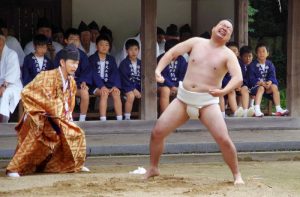 Spirit Fighting Sumo
Spirit Fighting Sumo
Oyamazumi Shrine, tucked away on tiny Omishima Island in the Seto Inland Sea, is one of the most important shrines in Japan and has its own sacred rice paddy. In early June, the shrine holds its annual Rice-Planting Festival. There are many rice planting festivals across the country but what makes this one stand out is a unique one-day sumo tournament known as Hitori-Sumo—which literally means “Solo Sumo”! A local wrestler fights the invisible spirit of rice over three matches, the outcome being an omen for the harvests to come. In times gone by, it’s likely that this ceremony was taken more seriously but these days, people attend more for the funny faces and comedic performance by the wrestler.
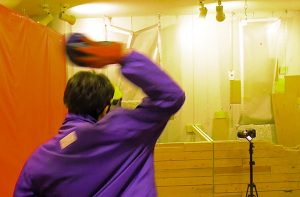 Smashing Good Fun
Smashing Good Fun
It’s no secret that Japan has an incredibly stressful work culture. White-collar workers often endure minimal holiday, long hours and horrific commutes on jam-packed trains. It’s therefore not a surprise that rage rooms have popped up in Osaka as a space where they can vent their frustrations… fiercely, but safely. Rage rooms are small spaces where visitors don protective gear, are given a pile of plates and are left to go wild. By hurling the plates against the far wall, organisers hope that patrons can relieve their stress in a safe and controlled environment.
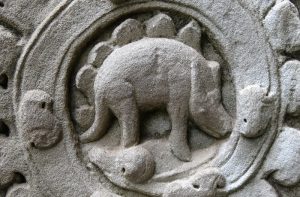 The Dinosaur of Ta Prohm
The Dinosaur of Ta Prohm
Despite dinosaurs being extinct for 65 million years, a small carving found at the 12th century temple of Ta Prohm (one of the most famous within the Angkor Archaeological Park) casts somewhat spurious but fun and light-hearted doubt on scientific fact. The carving resembles a Stegosaurus, and seemingly its species remarkably survived the asteroid impact by hiding out in the jungles of northern Cambodia. The carving has created some tabloid articles and hype among creationists.
If viewed at an angle it does resemble a dinosaur, but take a more direct look and the sculpture is a much better match for a boar or even a rhinoceros against a leafy background, which would have inhabited ancient Cambodia during the Angkor era. Other theories suggest the carving is a fabrication. Maybe it was created recently, perhaps by a visiting film crew as the temple is a favourite locale for filmmakers (Ta Prohm was the location for Tomb Raider).
Whatever the origin of the carving or what it depicts, it is a fun quirk for visitors to enjoy at the mesmerising monastic complex of Ta Prohm.
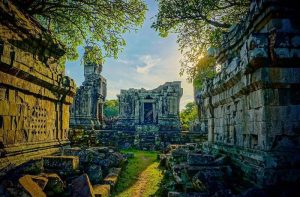 Phnom Bok & the Giant Linga
Phnom Bok & the Giant Linga
Phnom Bok is one of three iconic temple-mountains built by King Yasovarman I in the late 9th and early 10th centuries. The other hill top temple sites in the Angkor area are Phnom Bakheng which overlooks Angkor Wat and was once the capital of the Angkor civilisation and Phnom Krom, which is close to Tonle Sap Lake.
Secluded Phnom Bok is the least known of the three and the most challenging to access, but rewards those who ascend its 633 steps or trek a steep winding pathway snaking its way to the 235 metre summit. Spectacular views stretch across the Cambodian plains to Tonle Sap Lake and north to Phnom Kulen. During the civil war, artillery batteries were stationed on Phnom Bok near the temple to shell Khmer Rouge positions on Phnom Kulen. Now a peaceful, special atmosphere awaits with giant frangipani trees shading the ancient sandstone temple.
It is difficult to imagine the effort made to haul tons of stone up the mountain 1,000 years ago, but the king put the site under the protection of the Brahmanic Trinity of Shiva, Vishnu and Brahma, which in the history of the Khmer people was a time of exceptional unity. 150 metres west of the main temple a laterite platform carries an enormous monolithic sandstone linga 5 metres in height and over 1 metre in diameter, now toppled and partially broken, but surely the largest example in Southeast Asia. The effort that must have been required to transport this unique piece – the weight of which has to exceed 10 tons – defies belief.
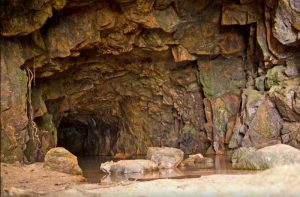 Kamikaze Caves of Hong Kong
Kamikaze Caves of Hong Kong
Japan’s Hong Kong-based ‘kamikaze team’ during the Second World War held a strategic location on Lamma Island known today as Kamikaze Caves. The caves provided cover for speedboats, deployed on suicide missions against Allied ships passing through. However, their first opportunity to deploy was during the Japanese surrender to the British, but upon launching it is said the Kamikaze boats were blown out of the water by Allied Aircraft carriers. So the concealed speedboats never completed their mission of destroying the passing ships.